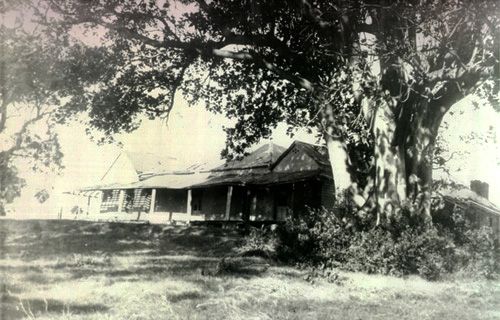

The following exerpt concerning Waratah House is from Ross M Deamer's Houses Erected on Original Land Grants in the Lower Hunter, Paterson and Williams River Valleys Between 1800 - 1850. [Submitted to the Faculty of Architecture, University of Newcastle, 1971 for the Degree of Master of Architecture. Thesis 309 pp 92-94.]
"Waratah House" was located on a grant of land made in favour of a Charles Simpson in 1831 in respect of his duties as a Collector of Customs in the Port of Newcastle. Shortly after the grant was made, Simpson had the land cleared and a farm established, during which time he began erecting his house which was completed by 1848. He named the house after the native shrubs growing in abundance in the area.
The house was "U" shaped in plan, the form being derived from a main central block consisting of four rooms two on each side of centrally placed hall. The main house block was roofed with shingles fixed to a framed hipped roof. This main portion was flanked by two service wings which appear to have had additions made particularly those sections adjacent to the main house which are roofed with a gable type roof. The majority of walls in the house were of brick, but it will be noticed in.the acompanying photograph, that the side walls of that portion of the wing adjacent to the main house were of weatherboard, so that this seems to suggest that these sections were additions and that originally the form of the house was composed of the main central portion surrounded by a verancah, linked by this device to the two wings at the rear. In support of this argument it may be also noted that the doors from the verandah to the sections concerned did not match those of the main section nor were they akin to any known examples of the 1830-1840 period. Similarly the posts supporting the verandah vary along its length, the corner post on the left of the verandah and those next to it are square in section, the other five in front of the central portion of the house are rectangular and their spacing is such, as to allow a return of the verandah on their module. Consequently when additions were made the verandah was extended to encompass the additions.
By taking into account the size of the chimney at the rear of the wing, on the right of the photograph, the assumption could be made that this section contained the kitchen, stores and other ancillary rooms of the household and that the other wing contained bedrooms for the family and guests. The main block possibly would then have contained the drawing rooms, dining room, and perhaps the master bedroom or library. This distribution of rooms within the plan form would then allow full advantage to be taken of the view across the river delta and its islands, as the main axis of the house was approximately in a north-south direction which would also allow the bedrooms the priviledge of the morning sunshine.
Gardens and lawns stretched from the house to the river, and from the verandah of the house, framed by the great figs and elevated on its knoll, must have presented a most impressive sight.
Beneath the house, cellars were built mainly to store the wine which was produced on the property.
The house was said to have been known as "Simpson's Folly" because of the distance it was located from Newcastle and Simpson's habit of commuting by boat. In those times it was a considerable distance for a man of business to remove himself from his base of operations, for as late as 1880, men of substance were erecting country houses, on the hills around the Newcastle basin and having town houses to accommodate their families through the week.
"Waratah House" was demolished in 1933 to allow The Broken Hill Proprietary Co. Ltd. to erect a pipe mill.
The property was sold to Major Charles Bolton after Mr. Simpson's death in 1850.
Major Bolton subdivided portion of the land soon after he purchased it and disposed of the remainder, in 1860, to Mr. T. Tourle who resided in the house until he died in 1890, after which the house had many owners until it was purchased by the B.H.P.
Back to the Mayfield Website